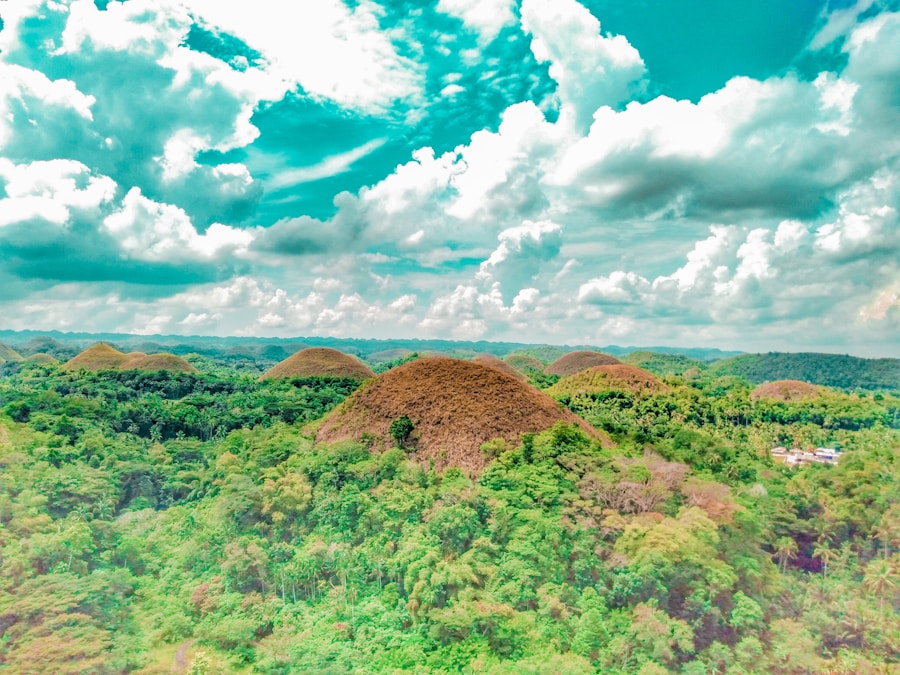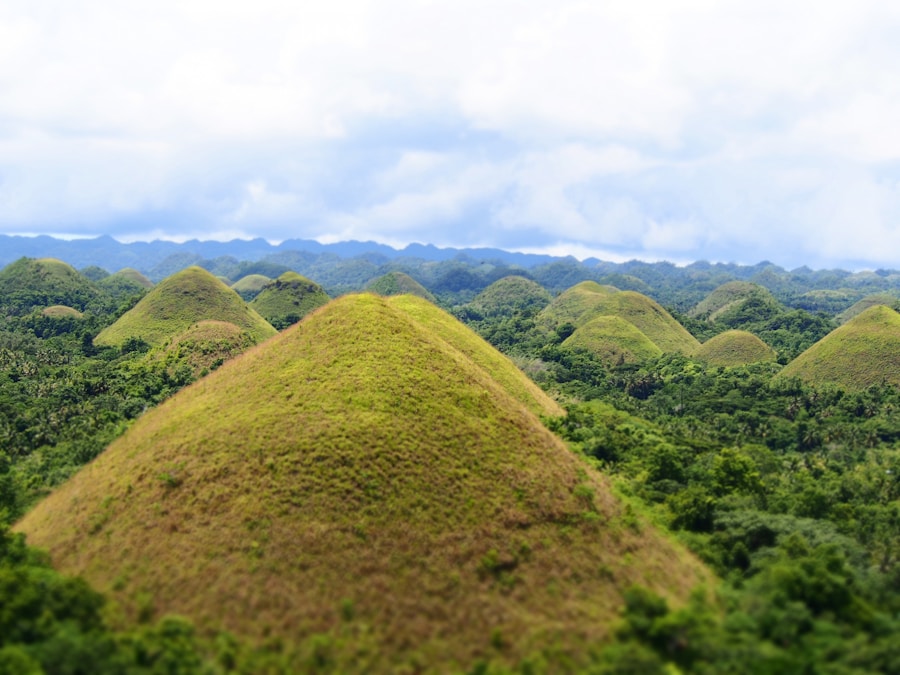Download links
How to install Exploring the Mysterious Chocolate Hills APK?
1. Tap the downloaded Exploring the Mysterious Chocolate Hills APK file.
2. Touch install.
3. Follow the steps on the screen.
Description
The Chocolate Hills, a geological wonder located in the Bohol province of the Philippines, have long captivated the imagination of both locals and tourists alike. Their name derives from the lush green grass that blankets these hills during the rainy season, which turns a rich brown hue during the dry season, resembling mounds of chocolate. The origin of these hills is steeped in local folklore and scientific inquiry, creating a fascinating tapestry of myth and geology.
According to local legend, the hills were formed from the tears of a giant who fell in love with a mortal woman. Heartbroken by her rejection, he wept for days, and his tears formed the hills that we see today. This story not only adds a layer of enchantment to the landscape but also reflects the deep cultural roots that the Chocolate Hills have in Filipino society.
From a scientific perspective, the formation of the Chocolate Hills is attributed to a combination of geological processes that took place over millions of years. The hills are primarily composed of limestone, which was formed from the accumulation of marine organisms in a shallow sea that once covered the area.
This erosion sculpted the hills into their current conical shapes, creating over 1,200 individual mounds spread across an area of approximately 50 square kilometers. The unique topography and geological history of the Chocolate Hills make them a subject of interest for geologists and tourists alike, as they represent a rare natural phenomenon that showcases the dynamic processes of Earth’s surface.
Key Takeaways
- The Chocolate Hills are a natural geological formation located in the Bohol province of the Philippines.
- The hills are made of limestone and were formed from the uplift of coral deposits and the action of rainwater and erosion over millions of years.
- The unique flora and fauna of the Chocolate Hills include various species of plants, birds, and mammals, some of which are endemic to the area.
- The Chocolate Hills hold cultural significance to the Filipino people, with various legends and myths surrounding their origin and formation.
- Visitors can explore the Chocolate Hills through activities such as hiking, zip-lining, and ATV tours, offering breathtaking views of the landscape.
- Efforts are being made to preserve the natural beauty of the Chocolate Hills, including reforestation and sustainable tourism practices to protect the environment and wildlife.
The Geological Formation of the Chocolate Hills
The geological formation of the Chocolate Hills is a remarkable example of karst topography, which is characterized by features such as sinkholes, caves, and limestone hills. The process began millions of years ago when the region was submerged under a shallow sea. During this time, marine organisms thrived, and their remains accumulated on the seabed, eventually forming thick layers of limestone.
The interplay between water, air, and biological activity initiated a slow but relentless process of erosion. Rainwater, slightly acidic due to dissolved carbon dioxide, began to seep into cracks and crevices in the limestone.
Over time, this chemical weathering eroded the rock, leading to the formation of distinct conical hills. The unique shape of each hill is attributed to variations in erosion rates influenced by factors such as vegetation cover and soil composition. The hills vary in height, with some reaching up to 120 meters.
The Chocolate Hills are not only a visual spectacle but also serve as an important geological site for studying karst landscapes and understanding the processes that shape our planet.
The Unique Flora and Fauna of the Chocolate Hills

The ecological diversity found within and around the Chocolate Hills is as striking as their geological features. The region is home to a variety of plant species that thrive in its unique environment. During the rainy season, the hills are covered with lush green grass and wildflowers, creating a vibrant landscape that attracts numerous species of insects and birds.
As the dry season approaches and the grass turns brown, many plants enter a dormant phase, showcasing their resilience in adapting to seasonal changes. Among the notable flora are endemic species such as the Bohol Bee-eater, a colorful bird known for its striking plumage and unique nesting habits. In addition to its diverse plant life, the Chocolate Hills also support a range of animal species that contribute to its ecological richness.
The area is home to various mammals, reptiles, and birds that have adapted to the specific conditions of this karst landscape. For instance, the Philippine tarsier, one of the world’s smallest primates, can be found in nearby forests. These nocturnal creatures are known for their large eyes and remarkable agility as they navigate through trees in search of insects.
The presence of such unique fauna highlights the importance of preserving this ecosystem, as it serves as a habitat for species that are not only rare but also integral to maintaining ecological balance.
The Cultural Significance of the Chocolate Hills to the Filipino People
| Aspect | Metrics |
|---|---|
| Number of Hills | There are estimated to be around 1,268 individual hills in the Chocolate Hills area. |
| Height of Hills | The hills vary in height, with the tallest reaching up to 120 meters (390 ft) in height. |
| Cultural Importance | The Chocolate Hills are considered a National Geological Monument and are a source of pride for the Filipino people. |
| Local Legends | Local folklore attributes the formation of the hills to a battle between two giants throwing rocks at each other, which then turned into the hills. |
| Tourism Impact | The Chocolate Hills are a major tourist attraction, drawing visitors from around the world to witness their unique beauty. |
The Chocolate Hills hold profound cultural significance for the Filipino people, particularly for those residing in Bohol. Beyond their natural beauty, these hills are woven into local folklore and traditions. They are often seen as symbols of love and heartbreak due to the legends surrounding their origin.
This connection to mythology fosters a sense of identity among locals who view the hills as more than just geological formations; they are part of their heritage and cultural narrative. Festivals and local events often celebrate this connection, drawing on stories that have been passed down through generations. Moreover, the Chocolate Hills have become an emblematic representation of Bohol itself, attracting visitors from around the world who seek to experience their beauty firsthand.
This influx of tourism has led to increased awareness and appreciation for local culture and traditions. Artisans and craftspeople often create works inspired by the hills, incorporating them into various forms of art and handicrafts that reflect both their natural beauty and cultural significance. As such, the Chocolate Hills serve not only as a natural wonder but also as a vital component of Bohol’s cultural landscape, fostering pride among its residents while promoting cultural exchange with visitors.
Exploring the Chocolate Hills: Activities and Tours
Exploring the Chocolate Hills offers visitors an array of activities that cater to different interests and preferences. One of the most popular ways to experience this natural wonder is through guided tours that provide insights into its geological history and cultural significance. Many tour operators offer packages that include visits to viewing platforms where tourists can take in panoramic views of the hills from elevated vantage points.
These platforms provide an excellent opportunity for photography enthusiasts to capture stunning images of this unique landscape. For those seeking adventure, hiking trails around the Chocolate Hills allow visitors to immerse themselves in nature while enjoying breathtaking views along the way. Some trails lead to lesser-known areas where tourists can experience a more intimate connection with the environment.
Additionally, biking tours are available for those who prefer a more active exploration method. These tours often include stops at nearby attractions such as local villages or historical sites, enriching the overall experience by providing context about Bohol’s rich heritage.
Preserving the Natural Beauty of the Chocolate Hills

As tourism continues to grow in popularity around the Chocolate Hills, efforts to preserve their natural beauty have become increasingly important. Environmental organizations and local government agencies are working together to implement sustainable tourism practices aimed at minimizing human impact on this delicate ecosystem. Initiatives include establishing designated pathways for visitors to follow while exploring the area, thereby reducing soil erosion and protecting native vegetation from trampling.
Education plays a crucial role in these preservation efforts as well. Informational signage has been installed throughout key areas to raise awareness about the ecological significance of the Chocolate Hills and promote responsible behavior among tourists. Local communities are also engaged in conservation efforts by participating in clean-up drives and reforestation projects aimed at restoring native flora around the hills.
By fostering a sense of stewardship among both residents and visitors, these initiatives aim to ensure that future generations can continue to enjoy and appreciate this remarkable natural wonder while safeguarding its ecological integrity for years to come.
FAQs
What are the Chocolate Hills?
The Chocolate Hills are a geological formation located in the Bohol province of the Philippines. They are made up of around 1,200 to 1,776 conical limestone hills, which are covered in green grass that turns brown during the dry season, giving them a chocolate-like appearance.
How were the Chocolate Hills formed?
The exact formation process of the Chocolate Hills is still a subject of debate among geologists. One theory suggests that they are the weathered formations of a marine limestone on top of an impermeable layer of clay. Another theory proposes that they are the result of the uplift of coral deposits and the action of rainwater and erosion.
What is the significance of the Chocolate Hills?
The Chocolate Hills are a popular tourist attraction in the Philippines and are considered a natural wonder. They have been declared the country’s third National Geological Monument and proposed for inclusion in the UNESCO World Heritage List.
Can visitors explore the Chocolate Hills?
Yes, visitors can explore the Chocolate Hills by climbing to the top of some of the hills, where they can enjoy panoramic views of the surrounding countryside. There are also viewing decks and platforms for tourists to take in the beauty of the landscape.
Is there any wildlife in the area of the Chocolate Hills?
The area surrounding the Chocolate Hills is home to a diverse range of flora and fauna, including various species of birds, butterflies, and plants. The hills are also part of the Chocolate Hills Complex, which includes a protected area for wildlife conservation.





